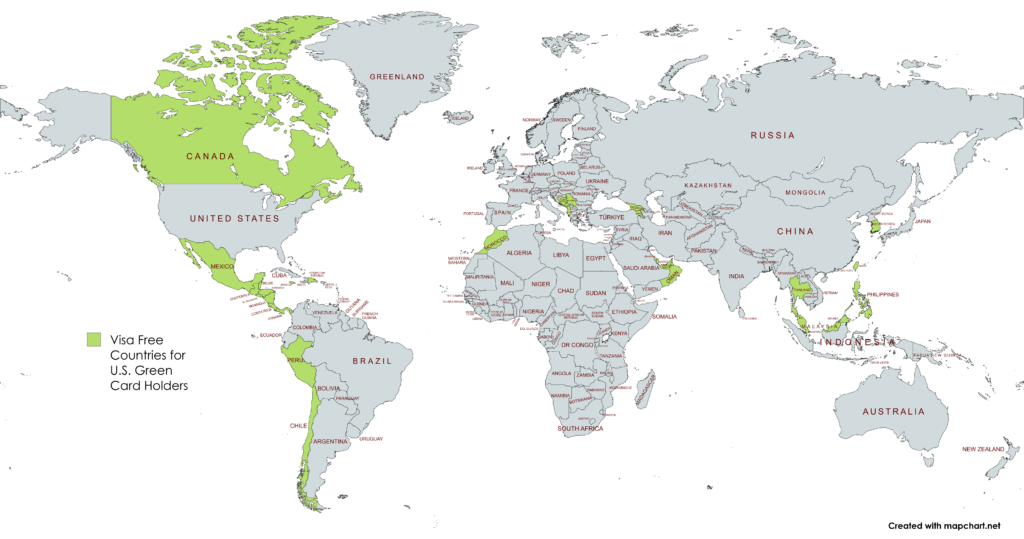The United States green card is one of the most popular permanent resident permits and opens several doors for social and economic opportunities to people from all over the world. As a foreign national with permanent residency in the United States, you should know that there are numerous U.S. green card visa-free countries to which you can easily travel. In fact, you are free to travel outside the United States to your home country and other countries of your choice with the privilege of visiting those countries without a visa. In this article, we’ll cover:
- Where green card holders can travel
- Regulations for traveling out and returning to the U.S.
- How long you can stay outside the United States
- Required documents for traveling out and returning to the U.S.
- Countries that grant a visa waiver for U.S. green card holders
Below you will find a map that outlines where visa-free countries for U.S. green card holders:
Where Can I Travel With a Green Card and Without a Visa?
With your green card, you can travel to a number of countries without a visa. The United States has an agreement known as a “good neighbor policy” with Canada and Mexico. With this policy, as a green card holder, you don’t need to obtain a visa before traveling to any of these two countries. You will, however, need to present your passport to enter those countries.
Apart from the countries under the good neighbor policy, you can also travel to some other countries for the purpose of tourism without a visa. Those countries include Albania, Anguilla, Antigua and Barbuda, Armenia, Aruba, Bahamas, Bahrain, Belize, Bermuda, Bonaire, Bosnia and Herzegovina, Cayman Islands, Chile, Costa Rica, Curaçao, Dominican Republic, El Salvador, Georgia, Guatemala, Honduras, Jamaica, Malaysia, Montenegro, Morocco, Nicaragua, Oman, Panama, Peru, Philippines, Qatar, Serbia, Singapore, Sint Maarten, South Korea, Taiwan, Thailand, Turks and Caicos, and United Arab Emirates also grant visa waivers to U.S. green card holders.
Learn more about Travelling with a Green Card.
Some of these countries have some restrictions for nationals of certain countries. Additionally, countries change their immigration laws from time to time. Therefore, before traveling to any of the countries or territories above, as a green card holder, it is recommended that you first check the requirements on their immigration website to be sure that a visa waiver is available to you.
Understanding the U.S. Green Card
The U.S. green card is the popular name for the official lawful permanent resident card (or I-551) issued to certain eligible foreign nationals by the United States Citizenship and Immigration Services (USCIS). There are two major immigration statuses for noncitizens in the U.S. — immigrant status and nonimmigrant status.
Those with green cards are considered to have immigrant status, an immigration term that implies the eligibility to live and work in the United States on a permanent basis. The term “nonimmigrants,” on the other hand, refers to those who are in the U.S. on a temporary visa and are required to return to their home country on or before the expiration of their status. You can become a green card holder through employment, investment, or family ties to a U.S. citizen or lawful permanent resident, as well as a few other means.
Where Can I Travel With My Green Card?
According to the USCIS, a lawful permanent resident is free to travel outside the U.S., and brief or temporary travel usually does not affect your status. This freedom is for both lawful permanent residents and conditional green card holders. However, your travel arrangements must be made according to the travel regulations for your status. This includes having necessary documents that will allow you to travel outside and reenter the U.S. Although there are many U.S. green card visa-free countries you can travel to, the travel period in itself can have a negative impact on your residency status, depending on your immigration restrictions.
Documents Needed to Travel Outside the United States
To travel to a foreign country, you will need to present your passport and your green card. You may also need some additional documents depending on the country you are traveling to. This is because some foreign countries have their own entry and exit requirements which must be respected by every visitor.
Documents Needed to Reenter the United States
In general, after a brief or temporary trip abroad, you will need to present your valid, unexpired green card (I-551) upon your arrival from the foreign country. At the port of entry, your green card and other means of identity—such as your passport or foreign national I.D.—will be reviewed by a U.S. Customs and Border Protection officer to determine if you can reenter the U.S. This requirement is applicable regardless of where the U.S green card holder traveled to a visa-free country or not.
How Long Can I Stay Outside the United States?
As a green card holder, you can travel and stay outside the United States for a period of six months without losing your permanent resident status. While your status grants you the freedom to travel in and out of the U.S., it is mandatory that you maintain legal status at all times, which includes establishing and maintaining a continuous physical presence. It is important to remember that traveling to visa-free countries for U.S. green card holders does not annul this requirement.
Staying abroad for more than six months but less than one year will likely lead to some questioning at the port of entry by the time you return to the United States. That doesn’t necessarily mean you will be denied entry as long as your journey abroad was within the parameters of your status. However, staying abroad for more than a year may indicate that you intend to abandon your permanent resident status. This is known as green card abandonment.
What Does Green Card Abandonment Mean?
Green card abandonment is a situation whereby a permanent resident gives up on his or her green card either intentionally or unintentionally. Staying outside the United States for too long is one of the acts that can be considered as having the intent of green card abandonment.
A general guide to determine whether or not abandonment has occurred is when you stay for more than a year abroad. In some cases, abandonment may be established if there are indications that you no longer have the intention of making the U.S. your permanent residence even during a brief or temporary journey that is less than a year.
After returning from a journey abroad, the CBP officer will base their assessment of your reentry eligibility on a number of criteria. This includes whether or not you maintained family and community ties, filed U.S. income taxes as a resident, and maintained U.S. employment while you were abroad.
They may also check to determine whether you maintained a U.S. mailing address, a valid U.S. driver’s license, a U.S. bank account, run a U.S. business, or own property in the United States. Maintaining any or some of these criteria will help in proving that your absence was indeed temporary and you had no intention of abandoning your permanent resident status.
What If I Want to Stay Longer Than One Year?
You may stay outside the United States for more than a year and still maintain your permanent resident status. This, however, has some requirements that must be put in place before you embark on the journey. To avoid denial at the port of entry, green card holders are advised to first apply for a re-entry permit before traveling outside the United States.
Whether you are a permanent or conditional green card holder, having a re-entry permit allows you to apply for admission to the U.S after returning from abroad without having to obtain a returning visa from a U.S. consulate or embassy. However, keep in mind that the permit will be issued with an expiration date, which means you can only use it to apply for admission on or before the expiration.
Expiration of Re-entry Permit
If you stay outside the United States for more than two years, your re-entry permit will have expired. In this scenario, you will have to obtain a returning resident visa (known as an SB-1) at a U.S. consulate or embassy. Applying for an SB-1 can be an extensive process that involves a medical exam, the establishment of eligibility for an immigrant visa, and other requirements.
This is why it is not advisable to stay longer than the expiration of your re-entry visa. However, just like a re-entry permit, a returning resident visa will also not automatically grant you admission after your journey. The purpose of these documents is to help prove your case at the port of entry.
What Happens If My SB-1 Application is Denied?
If, for any reason, the immigration officials deny your returning visa application, you will not be allowed to enter the U.S. unless you acquire another valid visa. The common reason for SB-1 denial is failing to demonstrate strong ties to the United States while you were away. In this case, your only option is to reapply for another immigrant visa, which can be under the same category you had previously or you can explore other available options.
The downside to this is that you will have to start the process all over again. For instance, if you apply for an employment or family-based green card, the process will cost you and your sponsor another round of expenses, force your sponsor to file a new petition, and have you attend another interview This could possibly have a very long processing time, and, in the end, there is no guarantee of getting it. This is why it is important to be cautious and ensure you don’t stay abroad for more than the stipulated time when you travel on your green card.
What Happens If I Lose My Green Card While I am Abroad?
It is not impossible for your green card or reentry permit to get lost or destroyed while you away. If this happens, you will need to file a Form, I-31A, Application for Travel Document (Carrier Documentation). Without having your green card, reentry permit, or I-131A, you will find it difficult to find an airline or any other transportation carrier back to the U.S. Allowing a traveler without proper documentation aboard a transportation carrier may lead to sanction on the company.
Does Travel Outside the U.S. Affect the Naturalization Process?
If you dream of becoming a U.S. citizen someday, you might want to take extra precautions when it comes to your stay outside the United States. According to the USCIS, “absences from the U.S. of six months or more may disrupt the continuous residency required for naturalization.”
During your naturalization process, you will be asked to disclose all trips taken outside the United States for the five years preceding the citizenship application. If you are found to have stayed abroad for more than a period of six months, this may affect your chances of citizenship eligibility. However, for those who must unavoidably stay abroad for a long period, there is a provision in the N-470 Application to Preserve Residence for Naturalization Process.
This application will help you preserve your status if you have to stay abroad for a period of one year or longer. The eligibility for the N-470 must be based on a very genuine, such as employment purposes for the U.S. government, a recognized U.S. firm, a mission, or denomination that has a bona fide organization in the U.S., and other recognized entities.
Frequently Asked Questions About Green Card Travel
Below you will find answers to the most commonly asked questions about visa-free travel for green card holders.
Can you travel with a green card/permanent resident card?
You are eligible to travel outside of the U.S. as a green card holder/permanent resident. U.S. permanent residents are allowed to travel anywhere in the world, depending on their ability to enter the country of their destination. However, as a green card holder, there are a number of visa-free countries that do not require any additional paperwork for entry. The proof of your U.S. green card will be enough to grant entry.
Can you fly with a green card?
Yes, as a green card holder you can board domestic and international flights. The Transportation Security Administration (TSA) accepts a variety of personal identification documents such as:
- U.S. green card;
- U.S. passport;
- Driver’s license;
- Border crossing card;
- An acceptable photo ID issued by a federally recognized Tribal Nation/Indian Tribe; and
- Many other forms of identification.
What are U.S. green card travel benefits?
There are several travel benefits to having a green card. Firstly, you can easily leave, enter, and re-enter the U.S. You will not be subject to denial of entry unless you violate the U.S. or international laws. Secondly, you are eligible to travel to many visa-free countries with your U.S. green card. To visit those countries, you will not need any additional paperwork or visas for entry. Your U.S. green card will be enough.
How VisaNation Law Group Can Help
While you are allowed to travel the world as a lawful permanent resident, it is important to take precautions on circumstances that could make you lose your green card or affect your eligibility for citizenship in the future. Whether you are already a green card holder or in the process of acquiring it, you need to know how to make the most of your status. This is why you should work with experienced green card immigration attorneys.
VisaNation Law Group has a team of highly experienced green card attorneys with extensive knowledge of the immigration rules for permanent residents, especially travel regulations. For a professional guide on your travel documentation, including a re-entry permit, or returning visa application, you can always count on them. Additionally, if your application for any of these has been denied, they can help you regain entry to the U.S. You can contact and book an appointment with VisaNation Law Group today by filling out this consultation form.



